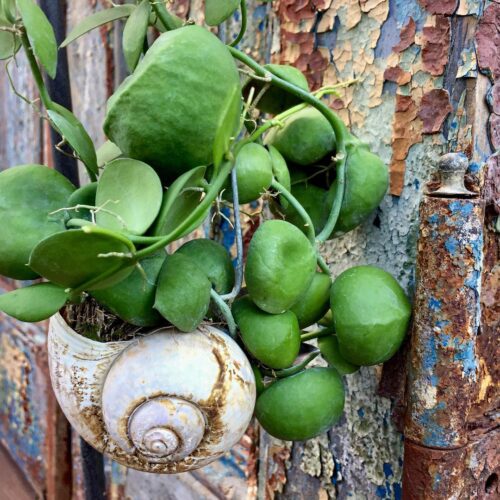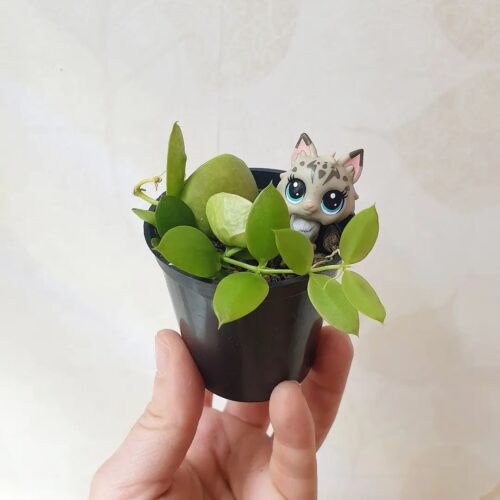Grow Dischidia Vidalii (Kangaroo Pocket) in your home with the help of this care guide with simple tips and tricks.
Dischidia Vidalii (Kangaroo Pocket) care is not difficult if you follow the right direction. Read this post to learn about all the essential requirements of this epiphyte.
Common Names: Bladder Vine, Ant Plant, Kangaroo Pouch, Kangaroo Pocket, Thruppence Ravioli Plant
USDA Zones: 11a-11b
Read: Dischidia hirsuta ‘Red Leaf’ Growing Tips & Care
Dischidia Vidalii (Kangaroo Pocket) Information

Native to the Philippines, this epiphyte grows on bamboo. This climbing plant features slender stems with fleshy, pale green leaves and modified ones that create a pouch filled with roots. The stems, up to 10 feet (3 m) long, either climb or hang, rooting at the nodes. The leaves are oval or lance-shaped, attached by a short petiole. Modified leaves, similar in color to regular ones externally but brown-red inside, are up to 2.8 inches (7 cm) long and 2 inches (5 cm) wide.
The bright red to magenta flowers, arranged in umbels, appear in leaf axils throughout the year. This plant forms a symbiotic relationship with ants; modified leaves offer shelter, and ants, in return, protect against pests and fertilize the plant with their waste.
Read: Dischidia Nummularia Care
How to Propagate Dischidia Vidalii (Kangaroo Pocket)
- Dischidia Vidalii, also known as Kangaroo Pocket, is easily propagated through stem cuttings.
- Choose a robust and healthy plant, then cut 4-6 inch sections using a clean, sharp knife or shears.
- Let the cut ends dry and form a callous for 6-10 hours before planting in a well-draining potting mix.
- Place the plant in an area with dappled light throughout the day, water it thoroughly, and roots should develop within 2-4 weeks.
Read: Dischidia Pectinoides Care
Ideal Growing Conditions for Dischidia Vidalii (Kangaroo Pocket)

Light
Dischidia Vidalii, or Kangaroo Pocket grows well in low-light conditions. The best position is an east or north-facing window, getting 4-5 hours of indirect sunlight each day. This plant works well in planters or hanging baskets on covered patios or porches.
Soil
Use a well-draining soil rich in organic content, such as shredded bark, coco coir, or orchid potting mix. Avoid regular potting mix, as the epiphytic roots of this plant need proper aeration to prevent suffocation.
Water
Let the soil dry before watering the plant. It’s accustomed to receiving moisture from dew and air. It can’t endure saturated soil. When the bark medium is dry, soak the container in water until air bubbles are gone.
Temperature and Humidity
Dischidia Vidalii (Kangaroo Pocket) appreciates hot and humid conditions. This plant is sensitive to frost or cold temperatures. An ideal temperature range is 40-80°F or 4-27°C with average household humidity.
For dry homes, consider using a humidifier or a pebble tray. Growing it in the kitchen or bathroom, which is typically more humid, is also an option.
Read: Tips to Grow Dischidia Geri in the Pots
Dischidia Vidalii (Kangaroo Pocket) Care
Fertilizer
If your plant is in a nutrient-rich medium, it might not need frequent fertilization. However, you can use a balanced, low-strength fertilizer once at the beginning of the growing season.
Pruning
Pruning is not essential for this plant, but you can trim it to control its size and shape.
Pests and Diseases
To maintain the health of your Kangaroo Pocket plant, be vigilant for common pests like aphids, mealybugs, spider mites, and fungus gnats. Also, prevent soil waterlogging to avoid root rot.
Read: The Ultimate Guide to Succulent Care: 6 Proven Tips
